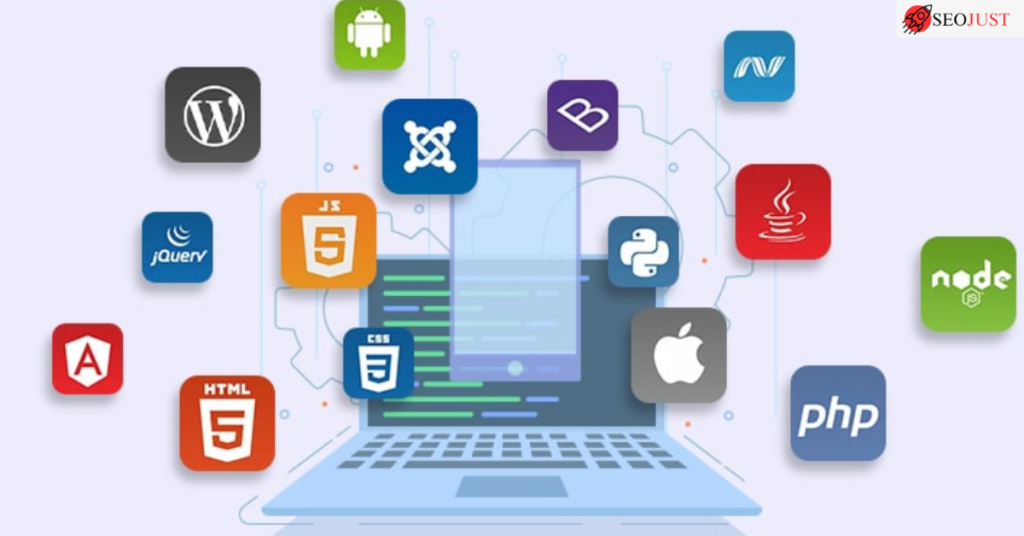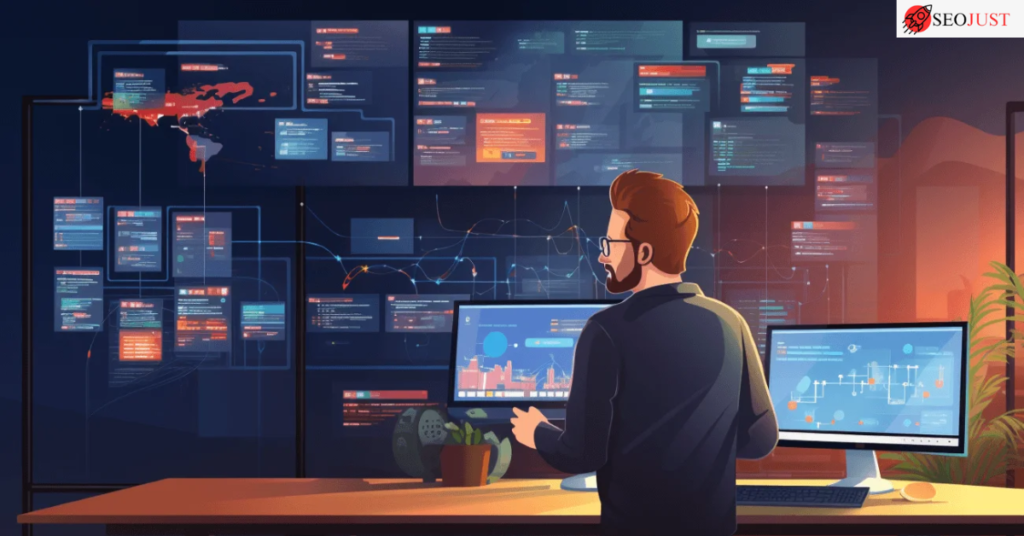Web tech refers to tools and techniques used to build websites and web-based applications. It has evolved from static pages to interactive platforms. Today, developers focus on technologies like AI, blockchain, and cloud computing to create more efficient, secure, and scalable solutions.
For the last 8 years, I have loved reading about tech and its advancements. In this researched blog, I’ve studied 70+ sites to get the insights and opinions for the 2025 tech era!
I will outline the vision, usage, and trends shaping web technology in 2025. I’ll also explore how these trends impact businesses, developers, and users.
Read More: Get_Ready_Bell:Client_Pulse
Vision of Web Technology
Web techn is expected to deliver utilitarian and reachable on the internet interfaces. It targets security, the ability to grow or expand, and customer-specific experiences. AI, cloud computing and blockchain are central to this vision.
The usage of serverless platforms and AI as a service to enhance the access for the users while developing it has been introduced by the developers in 2024. Chatbots and Augmented Reality (AR) are some of the tools that have made it easier for businesses to interact better with customers. Blockchain provides secure and irreversible transactions in any business or service.
The objective lies in achieving absolute global integrated electronic business environments with minimal entry hurdles for the users.
Key Tools and Technologies

1. Frameworks and Languages of Development
We build websites based on so-called Web Development Languages such as HTML, CSS and JavaScript. Structural platforms like React and Angular enhance the site’s performance and its use of interactive functions.
From here, JavaScript, which has already added types to itself, is TypeScript, which has become popular recently. When done correctly, 34% of recently opened-source development slowly detects bugs in advance.
These tools when learnt enables the developers to design websites that are responsive and load faster.
Read More: Alabama Technology Network
2. Application Programming Interfaces and Serverless Computing
APIs mentioned above make it very easy for a developer to link parts of a system. It helps to advance the construction process and also reduces mistakes.
The use of the serverless approach means cutting down infrastructure expenses by 30-40%. Thus, developers only have to pay attention to code. Third parties take care of all the rest for cloud providers. Netflix mentions 75 % faster deployment time with serverless technology.
3. Cloud Computing
Cloud computing is flexible and has a strong security measure. Applications execute on servers rather than on clients.
Currently, it is reported that between 60-68% of companies depend on cloud services. They add that this cuts infrastructure costs by 25-30%.
There is a great demand for flexible solutions in the context of using cloud; the market is expected to be $1 trillion by 2028.
Read More: Zhuoxin Data Technology Leadership
New Trends in Web Development

1. Progressive Web Apps (PWAs)
PWAs are used in similar ways that mobile apps are, but they are displayed and operated in a browser.
Overall, 40% enterprises using PWAs highlight increased engagement and 20% improved conversion rate of enterprise apps.
Real world examples include Pinterest PWA which gives users wider options for saving ideas and Starbucks which enables customers to use PWA for easy access to its services.
2. Mobile Web Pages (MWP)
AMPs strip away non-essentials in order to load the pages faster.
In 2017, websites adopting this technology surpassed 1.4 billion including the famous websites such as Buzzfeed and Business Insider. This data shows that faster pages have better SEO ranking and improved user engagement.
3. Voice Search Optimization
Voice search is advancing as more individuals embrace smart gadgets. Companies using websites that have been optimized for voice search see their revenues rise by 30%. Those firms that incorporate this technology stand to benefit from this.
Read More: How Does Granular Recovery Technology Work
Usage of AI and AR Technologies
1. AI Chatbots
AI chatbots handle customer queries and provide personalized experiences.
- 47% of businesses use chatbots for 24/7 support. Chatbots increase user retention by 50% and reduce wait times.
- Sephora and Bank of America rely on chatbots to enhance customer service.
2. Augmented Reality (AR)
AR technology adds digital layers to the real world.
- IKEA and Sephora use AR to let customers visualize products. This has boosted their conversion rates by 35-40%.
- AR improves user engagement and satisfaction, especially in online shopping.
3. AI in Web Design
AI tools assist in web design by automating routine tasks.
- AI-based tools reduce design errors by 20-30%. Developers can focus more on creativity, while AI handles repetitive coding.
Read More: Logitech Dongle Software
Blockchain and Web 3.0
Blockchain technology ensures security and transparency. It records transactions in a decentralized and tamper-proof way.
- 52% of financial institutions use blockchain for secure transactions. Web 3.0 builds on blockchain principles to give users more control.
- Web 3.0 aims to reduce intermediaries, creating a fairer and more transparent internet.
Motion UI and Dark Mode
Motion UI adds dynamic transitions to websites. This keeps users engaged.
- With an average attention span of 8.25 seconds, motion UI helps websites retain visitors.
- Dark mode is now a favorite. 82.7% of users switch to dark mode at night, reducing eye strain.
Personalization in Web Tech
Personalization is key to improving user experience. Websites and apps now show content tailored to individual preferences and behaviors. This trend uses AI and machine learning to analyze user data in real-time.

- 91% of consumers like shopping with brands that offer personalized recommendations.
- Streaming services like Netflix and Spotify recommend shows and music based on user habits. This results in over 75% of user activity coming from these suggestions.
Personalized experiences boost engagement by 20-30% and increase conversion rates. Companies that use personalization keep customers coming back. For example, e-commerce sites recommend products based on browsing history, which can raise sales by 25-30%.
How Personalization Works
- User Segmentation: Websites group users based on demographics like age and location.
- Behavior Tracking: Platforms monitor browsing patterns to suggest relevant content.
- Dynamic Content: Content changes in real-time based on past interactions.
Personalization is also important in email marketing. Companies send custom emails with tailored recommendations. These emails have 50% higher open rates than generic ones.
Businesses that ignore personalization risk losing customers to competitors. In the future, hyper-personalization will combine AI with IoT devices. This will provide highly customized experiences across platforms.
Read More: TechEmbers: Company Profile & Funding Overview
Low-Code and No-Code Platforms
Low-code and no-code platforms are changing web development. They let users with little coding experience build websites and applications. These platforms offer visual tools where users can drag and drop elements to create software. This speeds up development.
- By 2025, 65% of applications will be made on low-code or no-code platforms.
- Businesses using these tools can cut development time by 50-70%.
Benefits of Low-Code/No-Code Platforms
- Faster Development: Projects that took months can now be done in weeks.
- Cost Savings: Companies save money by needing fewer developers.
- Accessibility: Non-developers, like marketers, can create solutions without deep coding knowledge.
Platforms like WordPress, Wix, and Bubble are popular choices. They help small businesses build websites affordably. Even larger companies use low-code platforms to create internal apps quickly.
However, these platforms have some limits. Complex applications may still need custom coding. Developers are needed for integration with other systems. Still, low-code/no-code adoption is growing fast. More businesses are embracing the flexibility they offer.
In the future, AI will make these platforms even better. It will suggest design improvements and generate code based on user input. This trend will allow more people to join in software development, driving innovation.
Read More: FintechZoom GME Stock Forecast 2025–2030
Mobile-First Design
Mobile-first design is becoming essential in web development. This approach focuses on creating websites for mobile devices before desktop versions. As mobile usage continues to rise, businesses need to prioritize mobile experiences.
- Over 54% of global web traffic comes from mobile devices.
- Companies that use mobile-first design often see improved user engagement and higher conversion rates.
Designing for mobile first means creating simpler layouts and faster loading times. This ensures users have a smooth experience on smaller screens.
Key Principles of Mobile-First Design
- Responsive Layouts: Websites adjust to fit different screen sizes, ensuring usability across devices.
- Touch-Friendly Navigation: Buttons and links are larger and easier to click on mobile screens.
- Fast Loading Times: Optimizing images and content helps websites load quickly, which is crucial for mobile users.
Ignoring mobile-first design can lead to a poor user experience. Users may leave websites that are hard to navigate on their devices. In contrast, sites that focus on mobile design can see an increase in user satisfaction.
In the future, mobile-first design will continue to be a priority. With more people using smartphones and tablets, businesses must adapt to these changes to remain competitive.
Read More: Pedro Vaz Paulo
User Experience (UX) and User Interface (UI) Design
User experience (UX) and user interface (UI) design are critical in creating successful websites. UX focuses on how users interact with a site, while UI deals with how the site looks. Both elements must work together for an effective online experience.

- A good UX design can increase user retention by 40%.
- Attractive UI design can boost user satisfaction and brand loyalty.
Key Elements of UX/UI Design
- Usability: Websites should be easy to navigate. Users should find what they need without confusion.
- Visual Appeal: A well-designed UI captures attention and keeps users engaged.
- Accessibility: Websites must be usable for everyone, including people with disabilities.
Investing in UX/UI design leads to better user experiences. When users are happy with a site, they are more likely to return. Companies that prioritize UX/UI design often see higher conversion rates and customer loyalty.
As technology evolves, UX/UI design will also change. New tools and trends will emerge, allowing for even more engaging experiences. Businesses that stay ahead of these trends will maintain a competitive edge in the digital landscape.
FAQs
How does AI improve web development?
AI enhances user experience with chatbots and personalization. It automates routine tasks, allowing developers to focus on creativity.
Why is serverless architecture gaining popularity?
Serverless platforms reduce costs and simplify deployment. Developers can focus on coding, while cloud providers manage infrastructure.
What makes PWAs a good choice for businesses?
PWAs combine the best features of websites and mobile apps. They offer offline access, push notifications, and faster loading, improving engagement and conversions.
How does cloud computing support web development?
Cloud computing provides scalability, security, and flexibility. Developers can access resources from anywhere, without managing servers locally.
What is the future of web tech?
The future lies in AI, AR, blockchain, and decentralized networks. Developers will focus on creating secure, user-friendly platforms that provide personalized experiences.
Wrapping Up
Web tech in 2025 will offer smarter, faster, and more secure solutions. Key trends like PWAs, AMPs, AI chatbots, blockchain, and serverless architecture are transforming how websites and applications function.
Businesses and developers aim to create engaging, accessible, and efficient platforms. AI, AR, and blockchain will continue to shape digital interactions, giving companies a competitive edge.
The future of web development looks promising. With the right tools and technologies, developers can build powerful and intuitive applications that meet the needs of users worldwide.
Read More: Andre Amin Hakkak, White Oak Global Advisors LLC




